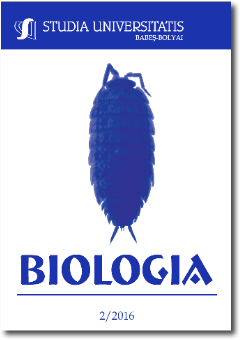Arsenite-induced activation of JNK1/2 and p38 MAP kinases in ELM-1 murine erythroleukemia cells
Keywords:
arsenite, erythroleukemia cells, JNK1/2, MAPK, p38.Abstract
Arsenite stimulates different mitogen-activated protein kinase (MAPK) pathways in the murine erythroleukemia cell line ELM-I-1. The activation of JNK1/2 and p38 was determined by Western blotting with antibodies specific for phosphorylated, activated forms of these kinases. Our data indicate that arsenite stimulates rapid phosphorylation of JNK1/2 and p38 MAPKs in ELM-I-1 cells. In the concentration range of 12.5-500 μM arsenite stimulates the stress response kinases JNK1/2 and p38. Maximal JNK1/2 and p38 activation was observed at 50 μM. This concentration produces an 7-40 fold increase in the activity of the JNK1/2, and an 4.5-7.5 fold increase in the activity of the p38 MAPK. The arsenite effects were time dependent: maximal activation of the stress response kinases JNK1/2 and p38 were observed after a 60 min exposure to arsenite.
References
Bernstam, L., Nriagu, J. (2000) Molecular aspects of arsenic stress, J. Toxicol. Env. Health Part B., 3, 293-322
Bode, A. M., Dong, Z. (2002) The paradox of arsenic: molecular mechanisms of cell transformation and chemotherapeutic effects, Critical Reviews in Oncology/Hematology 42, 5-24
Ellinsworth, D. C. (2015) Arsenic, Reactive Oxygen, and Endothelial Dysfunction, J Pharmacol Exp Ther 353, 458 – 464
Faita, F., Cori, L., Bianchi, F., Andreassi, M. G. (2013) Arsenic-Induced Genotoxicity and Genetic Susceptibility to Arsenic-Related Pathologies, Int. J. Environ. Res. Public Health 10, 1527-1546
Huang, C., Ma, W.-Y., Li, J., Goranson, A., Dong, Z. (1999) Requirement of ERK, but Not JNK, for Arsenite-induced Cell Transformation, J. Biol. Chem, 274(21), 14595-14601
Kyriakis, J. M., Avruch, J. (2012) Mammalian MAPK signal transduction pathways activated by stress and inflammation: a 10-year update, Physiol Rev 92, 689–737
Lau, A. T. Y., Li, M., Xie, R., He, Q. -Y., Chiu, J. -F. (2004) Opposed arsenite-induced signaling pathways promote cell proliferation or apoptosis in cultured lung cells, Carcinogenesis 25(1), 21-28
Li, J. -P., Lin, J. -C., Yang, J. -L. (2006) ERK Activation in Arsenite-Treated G1-Enriched CL3 Cells Contributes to Survival, DNA Repair Inhibition, and Micronucleus Formation, Toxicological Sciences 89(1), 164–172
Meriin, A. B., Yaglom, J. A., Gabai, V. L., Mosser, D. D., Zon, L., Sherman M. Y. (1999) Protein-Damaging Stresses Activate c-Jun N-Terminal Kinase via Inhibition of Its Dephosphorylation: a Novel Pathway Controlled by HSP72, Mol. Cell. Biol. 19(4), 2547-2555
Muscarella, E., Bloom, S. E. (2002) Differential Activation of the c-Jun N-Terminal Kinase Pathway in Arsenite-Induced Apoptosis and Sensitization of Chemically Resistant Compared to Susceptible B-Lymphoma Cell Lines, Toxicological Sciences 68, 82–92
Platanias, L. C. (2009) Biological Responses to Arsenic Compounds, J. Biol. Chem. 284, 18583-18587
Porter, A. C., Fanger, G. R., Vaillancourt, R. R. (1999) Signal transduction pathways regulated by arsenate and arsenite, Oncogene 18, 7794-7802
Reichard, J. F., Puga, A. (2010) Effects of arsenic exposure on DNA methylation and epigenetic gene regulation, Epigenomics 2(1), 87–104
Qu, W., Bortner, C. D., Sakurai, T., Hobson, M. J., Waalkes, M. P. (2002) Acquisition of apoptotic resistance in arsenic-induced malignant transformation: role of the JNK signal transduction pathway, Carcinogenesis 23(1), 151-159
Schaefer, A., Kósa, F., Bittorf, T., Magócsi, M., Rosche, A., Ramirez-Chávez, Y., Marotzki, S., Marquardt, H. (2004) Opposite Effects of Inhibitors of Mitogen-activated Protein Kinase Pathways on the Egr-1 and -Globin Expression in Erythropoietin- responsive Murine Erythroleukemia Cells, Cellular Signaling 16(2), 223-234.
Schaeffer, H. J., Weber, M. J. (1999) Mitogen-Activated Protein Kinases: Specific Messages from Ubiquitous Messengers, Mol. Cell. Biol. 19(4), 2435-2444
Theodosiou, A., Ashworth, A. (2002) Differential effects of stress stimuli on a JNK-inactivating phosphatase, Oncogene 21(15), 2387-2397
Tibbles, L. A., Woodgett, J. R. (1999) The stress-activated protein kinase pathways, Cell. Mol. Life Sci 55, 1230-1254
Ventura-Lima, J., Bogo, M. R., Monserrat, J. M. (2011) Arsenic toxicity in mammals and aquatic animals: A comparative biochemical approach, Ecotoxicology and Environmental Safety 74, 211–218
Wang, Z. -Y. (2001) Arsenic compounds as anticancer agents, Cancer Chemother Pharmacol 48(1), S72-S76
Downloads
Published
How to Cite
Issue
Section
License
Copyright (c) 2016 Studia Universitatis Babeș-Bolyai Biologia

This work is licensed under a Creative Commons Attribution-NonCommercial-NoDerivatives 4.0 International License.





